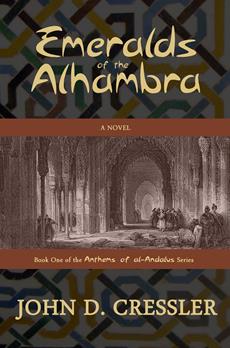Having just come to the end of the review cycle by the endorsers of Emeralds of the Alhambra, I have discovered something new in the process. Placing your ‘baby’ into the hands of a diverse set of very well-known people can be incredibly anxiety producing! Thankfully, the results have been truly gratifying. I thought Professor Susan Abraham’s review of Emeralds was particularly insightful. She “got” the broad themes of the book that I was striving for when I wrote it, and codified my message beautifully. I am including her review below. Enjoy!
Emeralds of the Alhambra, by John D. Cressler, to be released by Sunbury Press, June 15, 2013.

“John D. Cressler’s debut novel reveals the infinite artistic capacity of a polymath whose diverse interests create a vivid and gorgeous world of romance, intrigue, murder and negotiations between multiple religions in medieval Spain. Emeralds of the Alhambra is a fascinating and historically realistic portrayal of life in Muslim Spain in the 14th century. Cressler has woven an imaginative and intricately persuasive story that successfully does two things. One, the historical details provide for absorbing reading in the depiction of medieval Islamic, Jewish and Christian cultures and religious identities living side by side. Here, conflict, war, assassinations and cooperation for religious, cultural and political survival translate into lessons from history for our contemporary time. Second, a model for interreligious life emerges in these pages: one that is nurtured in the context of intimate, covenanted and familial relationality. Interreligious marriages have been in many parts of the world a prime vehicle for interreligious convivial life. The possibility of intimate love sprouting in the context of multiple religious identities is one that reveals the true meaning of “conversion” to the human and Divine Other. Cressler deftly presents his characters as multidimensional; Jews, Muslims and Christians are not Westernized caricatures of good and evil. The novel prods us to note that there never was a monolithic Christianity, Judaism or Islam in human history, a compelling lesson gleaned through Cressler’s artistic vision. The difference between the Muslim Maghreb and Muslim Granada are meticulously sketched in an imaginative frame to reveal its influence still being played out in our time.
Of the more evocative perceptions the reader is left with at the end of the novel is Cressler’s loving attention to the unparalleled beauty of the Alhambra and the manner that Muslim architecture presents the occasion for glorifying the divine in its sumptuous materiality. Cressler’s engineering reflexes, inflected with a deep love of beauty, are in full view in the various descriptions of the palaces and mosques of the Alhambra. In one exquisite passage describing the Hall of the Abencerrages within the Palace of the Lions, he writes: ‘The mocárabes coalesce into an elaborate eight-pointed star, the heavens, resting upon the cubic hall below, the earth, inviting the visitor’s gaze upwards to the divine….The calculus of the ceiling produces a meditative sculpture on the nature of time, the separation of heaven and earth, Allah and man.’
Emeralds of the Alhambra is a coruscant story of love between human beings, for God, and for the creation so graciously bestowed on us. A thoroughly gripping and engaging first novel.”
─Professor Susan Abraham, Harvard Divinity School